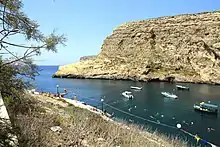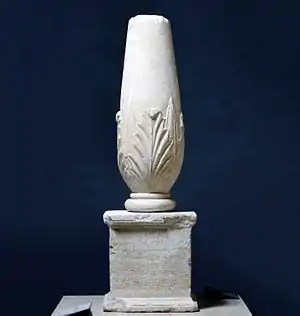Gozo Phoenician shipwreck
The Gozo Phoenician shipwreck is a seventh-century-BC shipwreck of a Phoenician trade ship lying at a depth of 110 meters (360 ft). The wreck was discovered in 2007 by a team of French scientists during a sonar survey off the coast of Malta's Gozo island. The Gozo shipwreck archaeological excavation is the first maritime archaeological survey to explore shipwrecks beyond a depth of 100 meters (330 ft).
 Gozo's Xlendi Bay, where the shipwreck was discovered. | |
| Location | Off the coast of Xlendi bay in Gozo |
|---|---|
| Region | Bay of Xlendi, off the coast of Gozo. |
| Type | Site of a sunken ship |
| History | |
| Builder | Phoenicians |
| Founded | 7th century BC |
| Abandoned | Sank late 7th century BC |
| Periods | Iron age |
| Cultures | Phoenician |
| Satellite of | Phoenicia |
| Associated with | Crew of the merchant vessel |
| Site notes | |
| Excavation dates | Excavation dives directed by Timmy Gambin since discovery in 2007. |
| Archaeologists |
|
| Condition | Conservation, sampling and study are ongoing |
| Ownership | Malta |
Historical background

The Phoenicians, a thalassocratic people known for trading and shipbuilding, had a long-standing presence in, and influence on the history of, the Maltese islands. From the middle of the second millennium BC, the Phoenicians undertook seaborne traffic from their mainland cities on the coast of modern-day Lebanon; their far-reaching trade routes spanned from the British Isles to Mesopotamia. The Phoenicians built trade outposts and colonies throughout the Mediterranean to facilitate the supply and storage of raw materials and goods.[2][3][4] Sometime after 1000 BC, Phoenician traders colonized the Maltese islands that were conveniently located at the center of the Mediterranean between Europe and North Africa.[5][6] They inhabited the area now known as Mdina and its surrounding town of Rabat which they called Maleth.[7][8] The area came under the control of Carthage after the fall of Tyre in 332 BC.[6][9] Punic influence remained on the Maltese islands during the early Roman era as demonstrated by the famous second century BC Cippi of Melqart that were pivotal in deciphering the Phoenician language.[10][11]
Phoenician shipwrecks
There are about six Phoenician shipwreck sites datable from the eighth to the sixth century BC in the Mediterranean. Two of these are located off the coast of Israel, at a depth of ~400 meters (1,300 ft),[12] three in shallow waters facing the Spanish coast and one in France.[13][14]
Location and discovery
The Gozo shipwreck was discovered in 2007 by a team of the French National Research Agency (ANR) during a seabed survey around 900 meters (3,000 ft) off the coast of Xlendi, on the Maltese island of Gozo. The team detected sonar anomalies at a depth of 110 meters (360 ft), prompting further investigation that led to the discovery of a sunken Phoenician trade ship with its well-preserved cargo dating to the seventh century BC.[15][16][17][18] The Gozo shipwreck archaeological excavation is the first maritime archaeological survey to explore shipwrecks beyond a depth of 100 meters (330 ft).[18] Further archaeological research off the coast of Malta was conducted by the ANR's GROPLAN project in collaboration with the University of Malta and Texas A&M University.[3]
Description
The shipwreck is 12 by 5 meters (39 by 16 ft). Archaeological artifacts are buried under up to 1.8 meters (5.9 ft) of sediment.[15] The ship remains and its upper layer of cargo lay exposed 1 meter (3.3 ft) above a relatively flat seabed of coarse sand; it consists of quern-stones and earthenware containers used to transport wine, olive oil, and other consumables.[15][17][18] Quern-stones, used to grind grains, were stored at both ends of the ship; they were discovered in pristine condition, indicating that they were never used and were destined for trade. Studies show that the grinding stones were made from volcanic rock sourced in Pantelleria in Sicily.[18][19] The wreck site is very well preserved, save for some minor damage caused by local fishermen's bottom-fishing techniques.[15]
Cargo and artifacts
Digital mapping and high resolution imaging of the site and of the visible artifacts was done in 2014 by an international team of scientists. The survey was performed using a manned submarine that was deployed to produce a 3D photogrammetric image, which helped identify at least seven types of ceramic vessels.[17][18][20] In 2016–2017, exploration of the wreckage resulted in the recovery of 12 objects, including uniquely shaped urns that appear to have been made on the island of Gozo.[17] Divers supervised by maritime archeologists from the Department of Classics and Archaeology at the University of Malta also recovered six intact ceramic objects and a large number of ceramic shards, among which were Tyrrhenian-style amphorae typical of Italy and western Sicily.[17]
Artifact recovery challenges
The extraction of artifacts from other parts of the ship proved difficult due to the depth of the shipwreck site. To facilitate artifact surfacing, a mooring dead weight was sunk to anchor the researcher's ship close to the shipwreck site. It took experienced divers eight minutes to reach the site, where they could stay for no longer than 14 minutes; surfacing objects took an additional two and a half hours.[17][18][21]
References
- "Exploring an archaic shipwreck off Xlendi Bay, Gozo". Phoenician Shipwreck. Retrieved 7 October 2020.
- "2,700-year-old Phoenician shipwreck discovered". www.history.com. Retrieved 7 October 2020.
- "Phoenician shipwreck located off coast of Malta". Biblical Archaeology Society. 12 October 2019. Archived from the original on 7 October 2020. Retrieved 7 October 2020.
- "Phoenician wreck is underwater world of discovery". Times of Malta. Archived from the original on 7 October 2020. Retrieved 7 October 2020.
- "Notable dates in Malta's history". Department of Information – Maltese Government. 6 February 2008. Archived from the original on 25 November 2009. Retrieved 6 February 2008.
- Ashby, Thomas (1915). "Roman Malta". Journal of Roman Studies. 5: 23–80. doi:10.2307/296290. JSTOR 296290.
- "Mdina & the knights". Edrichton.com. Archived from the original on 4 March 2016.
- Cassar, Carmel (2000). A concise history of Malta. Msida: Mireva Publications. pp. 53–55. ISBN 1870579526.
- Terterov, Marat (2005). Doing business with Malta. GMB Publishing Ltd. ISBN 978-1-905050-63-5. Archived from the original on 6 September 2015. Retrieved 1 July 2015.
- The Art Journal: The illustrated catalogue of the industry of all nations. 2. Virtue. 1853. p. vii. Archived from the original on 4 September 2015. Retrieved 15 February 2014.
- de Pasquale, Carmen (2009). "The Malta Cippus in the Louvre". Treasures of Malta. Fondazzjoni Patrimonju Malti. 16 (1). Archived from the original on 14 January 2021. Retrieved 14 January 2021 – via Fondazzjoni Patrimonju Malti.
- Ballard, R. D.; McCann, A. M.; Yoerger, D.; Whitcomb, L.; Mindell, D.; Oleson, J.; Singh, H.; Foley, B.; Adams, J.; Piechota, D.; Giangrande, C. (1 September 2000). "The discovery of ancient history in the deep sea using advanced deep submergence technology". Deep Sea Research Part I: Oceanographic Research. 47: 1591–1620. doi:10.1016/S0967-0637(99)00117-X.
- Ballard, Robert D.; Stager, Lawrence E.; Master, Daniel; Yoerger, Dana; Mindell, David; Whitcomb, Louis L.; Singh, Hanumant; Piechota, Dennis (2002). "Iron age shipwrecks in deep water off Ashkelon, Israel". American Journal of Archaeology. 106 (2): 151–168. doi:10.2307/4126241. ISSN 0002-9114.
- Abdelhamid, Selma. "Phoenician shipwrecks of the 8th to the 6th century B.C. – Overview and interim conclusions". Marburger Beiträge zur Archäologie, 2.
- Gambin, Timmy (October 2017). Between east and west – The Phoenician shipwreck off Gozo (PDF) (Report). University of Malta – Department of Classics & Archaeology. Archived from the original (PDF) on 6 November 2020. Retrieved 6 November 2020.
- Gambin, Timmy (November 2018). The Phoenician shipwreck off Gozo – 2018 season (PDF) (Report). University of Malta – Department of Classics & Archaeology. Archived from the original (PDF) on 6 November 2020. Retrieved 6 November 2020.
- Archaeology, Current World (25 April 2018). "Excavating a Phoenician shipwreck off the coast of Gozo, Malta". World Archaeology. Archived from the original on 7 October 2020. Retrieved 7 October 2020.
- "Exploring an archaic shipwreck off Xlendi Bay, Gozo". The Phoenician Shipwreck Project. Archived from the original on 7 October 2020. Retrieved 7 October 2020.
- "Divers discover Phoenician treasures in ancient shipwreck". The Telegraph. Retrieved 7 October 2020.
- "Continuano le ricerche sul relitto fenicio di Gozo, Malta". Ocean 4 Future (in Italian). 29 January 2019. Retrieved 7 October 2020.
- Gambin, T.; Drap, P.; Cheminsky, B.; Hyttinen, K.; Kozak, G. (2018). "Exploring the Phoenician shipwreck off Xlendi bay, Gozo: A report on methodologies used for the study of a deep-water site" (PDF). Underwater Technology. Society for Underwater Technology. 35 (3): 71. doi:10.3723/ut.35.071. ISSN 1756-0543. Archived from the original (PDF) on 9 November 2020.
